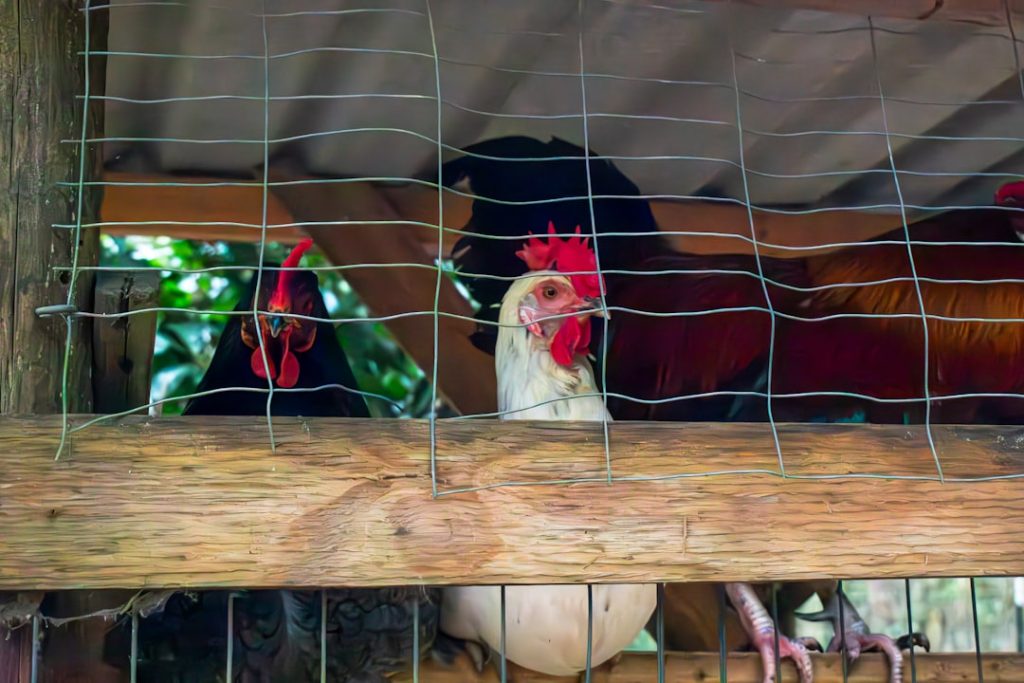Chickens exhibit natural curiosity and social behavior, with a strong instinct to explore their environment. They are creatures of habit, typically returning to the same roosting locations each night. Understanding these behavioral patterns is essential for effectively deterring chickens from undesired areas.
By recognizing their innate tendencies, one can implement strategies to discourage roosting in specific locations. Chickens are sensitive to environmental changes and can be easily startled by sudden movements or loud noises. As a result, deterrent methods should be introduced gradually to minimize stress on the birds.
It is also important to consider the hierarchical structure within a chicken flock, as dominant individuals may be more resistant to change and more challenging to deter. A comprehensive understanding of chicken behavior allows for the development of tailored approaches to effectively discourage roosting in unwanted areas.
Table of Contents
- 1 Creating Physical Barriers
- 2 Using Natural Deterrents
- 3 Implementing Repellents
- 4 Providing Alternative Roosting Areas
- 5 Consistent Training and Reinforcement
- 6 Seeking Professional Help
- 7 FAQs
- 7.1 What are some effective ways to keep chickens off the deck?
- 7.2 Why is it important to keep chickens off the deck?
- 7.3 Are there any natural methods to deter chickens from the deck?
- 7.4 Can training chickens to stay off the deck be effective?
- 7.5 What are some potential risks of having chickens on the deck?
Key Takeaways
- Chickens are naturally curious and will explore their surroundings, so understanding their behavior is key to deterring them from unwanted areas.
- Physical barriers such as fences and netting can effectively keep chickens out of specific areas and protect gardens or crops.
- Natural deterrents like predator decoys, reflective objects, or noise-making devices can help keep chickens away from certain areas.
- Repellents such as sprays or granules can be used to discourage chickens from roosting or nesting in unwanted areas.
- Providing alternative roosting areas, such as designated chicken coops or shelters, can help redirect chickens to more suitable locations.
- Consistent training and reinforcement of boundaries and rules can help teach chickens where they are and are not allowed to go.
- Seeking professional help from a veterinarian or animal behaviorist may be necessary for persistent chicken behavior issues.
Creating Physical Barriers
Installing Fencing and Netting
One effective way to deter chickens from roosting in specific areas is to create physical barriers that prevent them from accessing those spaces. This can be achieved by installing fencing or netting around the perimeter of the area you want to protect. The fencing should be tall enough to prevent the chickens from flying over it and sturdy enough to withstand their attempts to break through.
Covering Openings and Gaps
Additionally, you can use hardware cloth or chicken wire to cover openings or gaps where chickens may try to squeeze through.
Using Roosting Spikes or Strips
Another physical barrier that can be effective is the use of roosting spikes or strips. These are designed to make roosting surfaces uncomfortable for chickens, as they are unable to find a comfortable foothold. By installing these spikes or strips on ledges, beams, or other roosting spots, you can discourage chickens from settling in those areas.
Maintenance is Key
It’s important to regularly inspect and maintain these physical barriers to ensure their effectiveness over time.
Using Natural Deterrents

In addition to physical barriers, natural deterrents can also be effective in deterring chickens from roosting in unwanted areas. One common natural deterrent is the use of predator decoys, such as fake owls or hawks. These decoys can create the illusion of a threat, causing the chickens to avoid roosting in those areas.
It’s important to regularly move these decoys around to prevent the chickens from becoming accustomed to their presence. Another natural deterrent is the use of reflective surfaces, such as aluminum foil strips or CDs, which can create flashes of light that startle and deter the chickens. Additionally, planting thorny or prickly bushes around roosting areas can make those spots less appealing for chickens.
These natural deterrents work by leveraging the chickens’ natural instincts and aversions, making them effective and humane ways to discourage roosting in specific areas.
Implementing Repellents
Repellents can also be effective in deterring chickens from roosting in unwanted areas. There are various commercial repellents available that are specifically designed to deter birds, including chickens. These repellents often contain natural ingredients with strong odors or tastes that are unpleasant to chickens, such as garlic, peppermint, or capsaicin.
By applying these repellents to roosting surfaces or around the perimeter of the protected area, you can discourage chickens from settling in those spots. Another effective repellent is the use of citrus-based sprays or solutions, as chickens are known to dislike the smell of citrus. By regularly applying these repellents to roosting areas, you can create an environment that is unappealing to chickens, encouraging them to seek alternative roosting spots.
It’s important to reapply these repellents regularly, especially after rain or heavy winds, to ensure their continued effectiveness.
Providing Alternative Roosting Areas
One proactive approach to deterring chickens from unwanted roosting areas is to provide alternative roosting spots that are more appealing to them. This can be achieved by installing designated roosting poles or platforms in a different location that meets the chickens’ natural preferences for roosting. These alternative roosting areas should be elevated and provide a comfortable and secure space for the chickens to settle in at night.
Additionally, providing nesting boxes with comfortable bedding material can encourage chickens to roost in those areas instead of unwanted locations. By offering alternative roosting areas that meet the chickens’ needs and preferences, you can effectively redirect their behavior and discourage them from roosting in specific spots.
Consistent Training and Reinforcement

Discouraging Unwanted Behavior
For example, if you notice chickens attempting to roost in a specific area, you can gently but firmly discourage them by using verbal commands or gentle physical redirection.
Persistence is Key
It’s important to be patient and persistent with this approach, as it may take time for the chickens to change their behavior.
Positive Reinforcement
Additionally, positive reinforcement can be used to encourage the chickens to roost in designated areas by providing treats or rewards when they choose the desired roosting spots. By consistently training and reinforcing the desired behavior, you can effectively deter chickens from roosting in unwanted areas.
Seeking Professional Help
If all else fails, seeking professional help may be necessary to effectively deter chickens from unwanted roosting areas. Professional animal behaviorists or poultry experts can provide valuable insights and guidance on how to address specific behavioral issues with chickens. They can offer tailored solutions and strategies based on their expertise and experience working with poultry.
Additionally, professional pest control services may be able to provide effective deterrent methods that are specifically designed for deterring birds, including chickens. These professionals can assess the situation and recommend appropriate measures to discourage chickens from roosting in specific areas. By seeking professional help, you can access specialized knowledge and resources that can help effectively address the issue of unwanted chicken roosting.
In conclusion, understanding the behavior of chickens is crucial when it comes to deterring them from unwanted roosting areas. By creating physical barriers, using natural deterrents, implementing repellents, providing alternative roosting areas, and consistently training and reinforcing desired behaviors, you can effectively discourage chickens from settling in specific spots. If these efforts prove ineffective, seeking professional help may be necessary to address the issue and find a suitable solution.
With patience, persistence, and the right strategies in place, it is possible to successfully deter chickens from unwanted roosting areas while ensuring their well-being and comfort.
If you’re looking for more information on keeping chickens, you might be interested in this article on where to put a chicken coop. It offers valuable tips on finding the best location for your coop to ensure the health and safety of your chickens.
FAQs
What are some effective ways to keep chickens off the deck?
Some effective ways to keep chickens off the deck include installing physical barriers such as fences or netting, using repellents such as citrus peels or vinegar, and training the chickens to stay away using positive reinforcement.
Why is it important to keep chickens off the deck?
Keeping chickens off the deck is important to maintain a clean and sanitary outdoor living space, prevent damage to the deck from scratching and pecking, and minimize the risk of slipping and falling due to chicken droppings.
Are there any natural methods to deter chickens from the deck?
Yes, there are natural methods to deter chickens from the deck such as using citrus peels, vinegar, or other strong-smelling substances that chickens find unpleasant. Additionally, planting certain herbs or flowers that chickens dislike can also help deter them from the deck.
Can training chickens to stay off the deck be effective?
Yes, training chickens to stay off the deck can be effective through positive reinforcement techniques such as using treats to encourage them to stay in designated areas away from the deck. Consistency and patience are key when training chickens.
What are some potential risks of having chickens on the deck?
Having chickens on the deck can pose risks such as damage to the deck surface, accumulation of droppings leading to unsanitary conditions, and potential safety hazards for both humans and chickens.
Meet Walter, the feathered-friend fanatic of Florida! Nestled in the sunshine state, Walter struts through life with his feathered companions, clucking his way to happiness. With a coop that’s fancier than a five-star hotel, he’s the Don Juan of the chicken world. When he’s not teaching his hens to do the cha-cha, you’ll find him in a heated debate with his prized rooster, Sir Clucks-a-Lot. Walter’s poultry passion is no yolk; he’s the sunny-side-up guy you never knew you needed in your flock of friends!







